Introduction

Have you ever noticed those captivating ads that play before, during, or after a movie at the theater? Well, that's what we call cinema advertising, and it's a powerful marketing strategy! It's also known as in-theater advertising or movie theater advertising. The idea is to promote products, services, or brands to a captive audience while they're enjoying a movie on the big screen.
The cool thing is, as more and more people enjoy going to the movies for a fun time out, businesses have realized the huge potential of reaching a large and engaged audience through this medium. It's like having a captive audience, literally!
But here's the deal - the world of advertising is always evolving. To make the most of this dynamic industry, staying ahead of the curve is crucial. That's why we're also going to take a peek into the future trends of cinema advertising. We want to ensure your marketing strategies stay fresh, innovative, and totally on point.
Therefore, in this guide, we'll explore the captivating world of cinema advertising and discover how it can elevate your marketing game like never before.
Get ready for an adventure that will leave a lasting impact on your brand's success!
The History of Cinema Advertising
Early Beginnings: The Silent Film Era (Early 1900s)
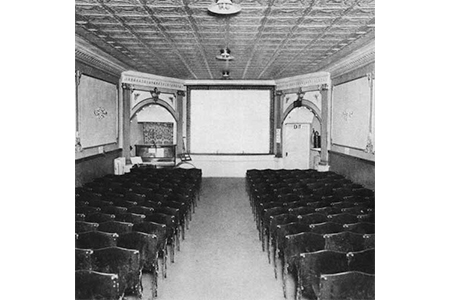
Cinema advertising dates back to the early 1900s, when silent films dominated the screen. Advertisers spotted the chance to reach a captive audience inside cinema theatres and began using short slides and text-based messages before the main feature. These early cinema ads are some of the first cinema advertising examples, setting the stage for a medium that would grow rapidly in influence.
The Golden Age of Cinema Advertising (Mid-20th Century)

The mid-20th century is often called the golden age of cinema advertising. This era was characterized by striking visuals, catchy jingles, and campaigns that remain memorable to audiences. Advertising in cinema theatres became more than a prelude to the film; it was an expected part of the overall experience, showing the power of cinema ads to connect with emotions.
Expansion with Multiplexes and Pre-Show Commercials (1980s Onward)
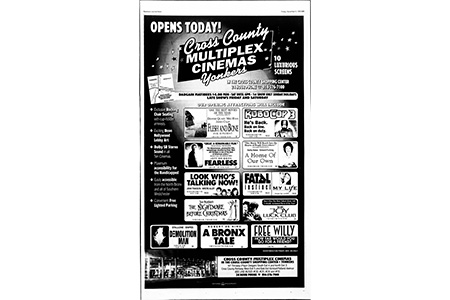
The 1980s brought multiplex culture, which completely changed the scale of cinema advertising. Pre-show commercials became standard, giving brands more screen time. As the demand grew, so did questions about cinema advertising cost, cinema ads cost, and cinema advertising rates, as marketers began comparing the price of advertising in cinemas with TV and print campaigns. This period also marked the start of different types of cinema advertising, from local slides to polished national campaigns.
Digital Evolution and Immersive Experiences (2000s–2010s)

The 2000s took cinema advertising into the digital age. High-definition formats, surround sound, and 3D technology turned ads into experiences rather than interruptions. Some of the best cinema advertising examples from this period used immersive visuals that blurred the line between storytelling and marketing, making cinema theatres an unbeatable platform for impact.
The Rise of Personalization and Cross-Platform Integration (2010s–Present)
With data-driven insights, cinema advertising became more personalized. Today, brands can tailor cinema ads to specific audiences, making campaigns more effective. Integration with mobile devices and social media further boosts reach, making the cinema advertising price worth it for many marketers. This cross-platform synergy has kept advertising in cinema theatres relevant in the digital-first world.
Today and Beyond: A Medium of Emotional Connection
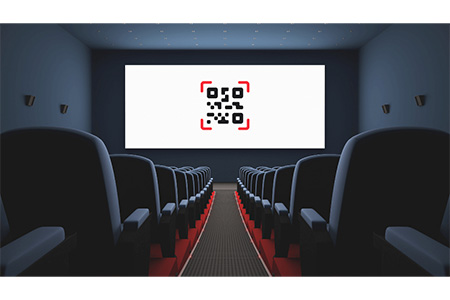
Despite the rise of streaming platforms, cinema advertising remains a powerful tool. Movie theatres provide a unique environment where brands can connect with audiences free from distractions. Whether a business is considering types of cinema advertising or evaluating cinema advertising cost, the emotional impact of the big screen makes it one of the most memorable ways to advertise. As technology continues to evolve, cinema ads will keep adapting, while still holding onto their core strength: an unmatched ability to create lasting impressions.
How does Cinema Advertising work?

Cinema advertising works by placing brand messages in front of an audience that is already tuned in for an immersive experience. Inside a theatre, distractions are minimal, which makes advertising in cinema theatres a powerful way to capture attention. Unlike other media where viewers can skip or ignore ads, cinema ads play on the big screen in a setting where the audience is fully engaged.
There are several types of cinema advertising. Some brands use short slides or static visuals before the film begins, while others opt for polished video commercials during the pre-show. Local businesses often use simple on-screen messages, while national brands invest in high-quality campaigns. You’ll also see cinema advertising examples on tickets, posters, standees, or even in the lobby.
The choice usually depends on the campaign objective and the cinema advertising cost involved. Factors like screen size, location, audience profile, and duration influence the final cinema advertising price. Businesses often compare cinema ad costs and cinema advertising rates with TV, print, or digital campaigns, but the unique impact of cinema often makes it worth the spend.
What makes cinema advertising effective is the mix of storytelling and environment. Audiences come ready to be absorbed in visuals and sound, and well-crafted cinema ads seamlessly blend into that journey, leaving a stronger recall than most other platforms.
How To Choose The Right Cinema Advertising Platform
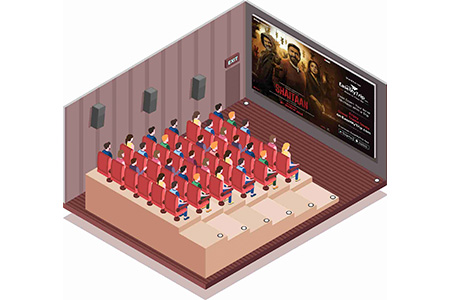
Selecting the right cinema advertising platform is crucial to ensuring the success of your marketing campaigns and reaching your target audience effectively. Here are some essential steps to guide you in making the best choice for your brand:
Audience Reach and Demographics
Consider the cinema advertising platform's audience reach and demographics. Analyze whether their theaters attract your target audience. Understanding the demographics of moviegoers who frequently visit theaters will help you align your ads with the right audience.
Geographical Coverage
Evaluate the geographical coverage of the cinema advertising platform. Ensure that it aligns with your marketing objectives and geographic target areas. Choosing platforms with a presence in locations where your brand has a strong customer base will enhance the impact of your ads.
Screen Network and Locations
Examine the screen network and locations offered by the platform. Some platforms might have partnerships with premium theaters or specific cinema chains. Opt for a platform that aligns with your brand's image and the types of movies that resonate with your target audience.
Advertising Formats
Review the advertising formats available on the platform. From traditional on-screen ads to interactive and immersive experiences, different formats offer varying levels of engagement. Choose formats that align with your advertising goals and provide the best opportunity to showcase your brand creatively.
Data and Analytics
Look for platforms that offer robust data and analytics capabilities. Understanding the performance of your cinema ads is essential for measuring success and refining future campaigns. Seek platforms that provide insights into audience engagement, ad impressions, and other relevant metrics.
Additional Marketing Opportunities
Consider whether the platform offers additional marketing opportunities beyond on-screen ads. Some platforms may provide opportunities for in-lobby displays, branded experiences, or social media integrations, extending the reach of your campaign.
Budget and Cost-Effectiveness
Evaluate the cost-effectiveness of the platform within your marketing budget. Compare the pricing models and ad packages offered by different platforms to find the best fit for your campaign objectives.
Different Types of Cinema Ads
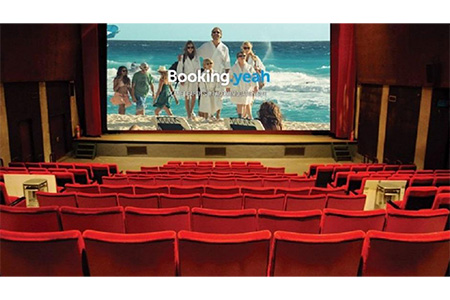
Cinema advertising presents a captivating array of formats to engage moviegoers and deliver compelling brand messages on the grand stage of the big screen. From on-screen commercials to immersive branded experiences, each type of cinema ad offers a unique way to captivate audiences and leave a lasting impact.
Let's understand the various types of ads that you can leverage to connect with your target audience in a movie theater setting.
On-Screen Ads
Commonly displayed before the movie starts, on-screen ads can be static images, video commercials, or animated clips, providing a creative canvas for brands to engage the audience.
In-Seat Ads
Captivating moviegoers with visibility on seatbacks or headrests, in-seat ads create an immersive advertising experience using QR codes, AR elements, or interactive content.
In-Lobby Displays
Positioned strategically in cinema lobbies, these displays include digital screens, posters, and standees to capture the attention of moviegoers during entry, exit, and intermission.
Branded Experiences
Offering interactive installations or activations within the theater, branded experiences create memorable interactions that leave a lasting impression on the audience.
Product Placements
Seamlessly integrating branded products or logos into movies, product placements provide subtle yet effective advertising opportunities.
Sponsored Movie Events
Brands can sponsor special movie events or premieres, associating their name with the excitement and glamour of the film industry.
The future of cinema advertising is promising, with innovations like interactive ads, virtual reality experiences, and personalized targeting on the horizon.
By understanding the different types of cinema ads, you can tailor your brand's advertising strategies to effectively engage moviegoers, elevate brand recognition, and make a powerful impact on the big screen.
What Are The Costs Of Cinema Advertising?

Cinema Chain and Location
The cinema advertising cost often depends on the theatre chain and its location. Premium multiplexes in metropolitan areas usually have higher cinema advertising rates than single-screen theatres in smaller towns. Brands choose placements based on where their target audience is most likely to watch films.
Ad Format and Duration
Different types of cinema advertising come with different pricing. A static slide, a 10-second spot, or a full 60-second commercial will all have different cinema advertising price brackets. Naturally, longer ads or high-production cinema ads shown in surround sound and HD formats command a higher cost.
Show Timing and Frequency
Peak show timings, such as weekend evening shows or big movie releases, attract larger audiences, making them more expensive for advertising in cinema theatres. The frequency of your ad—whether it plays before every show or only during select screenings—also affects the overall cinema ads cost.
Campaign Duration and Volume
A single-week campaign will cost less than a three-month placement. Similarly, running ads across multiple screens or cities increases the scale, but many cinema chains offer discounted cinema advertising rates for bulk bookings or longer commitments.
Target Audience and Demographics
Targeting specific genres or movies allows brands to reach certain demographics more precisely. For instance, family-friendly films attract parents and children, while action blockbusters draw younger audiences. Such targeting can influence both cinema advertising cost and effectiveness.
Negotiation and Custom Packages
Cinema chains often provide custom packages that combine on-screen ads with lobby displays, standees, or ticket branding. These negotiated bundles can make cinema advertising prices more efficient, giving brands added visibility at a better value.
Cost vs. Value Proposition
While cinema advertising rates may seem higher compared to some digital platforms, the impact is often unmatched. Audiences inside theatres are more attentive and less distracted, making the return on investment stronger. Successful cinema advertising examples show that the emotional connection built on the big screen often justifies the spend.
How To Create A Successful Cinema Ad?
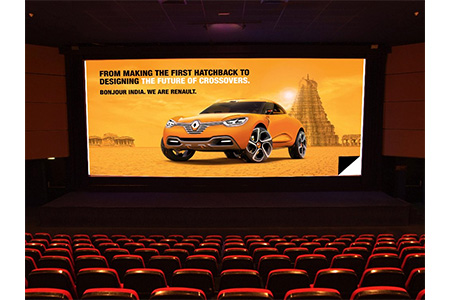
Creating a successful cinema ad involves careful planning, creative execution, and a deep understanding of the target audience and the cinema environment. Here are some essential steps to help you craft a compelling and impactful cinema ad:
Know Your Audience
Understand your target audience's preferences, interests, and demographics. Tailor your message to resonate with moviegoers, considering the movies they are likely to watch in theaters
Set Clear Objectives
Define specific goals for your cinema ad. Whether it's to increase brand awareness, promote a product, or drive website traffic, having clear objectives will guide the creative process.
Creative Concept and Storytelling
Develop a creative concept that aligns with your brand identity and objectives. Use storytelling techniques to craft a narrative that captivates and engages the audience emotionally.
Leverage the Cinema Environment
Take advantage of the cinematic experience to create an immersive ad. Utilize high-quality visuals and audio to make a lasting impression on the big screen.
Keep it Concise
Ads have a limited time, typically ranging from 15 seconds to a couple of minutes. Ensure your message is concise and impactful to make the most of the allotted screen time.
Call to Action (CTA)
Include a clear and compelling call to action in your ad. Encourage viewers to take the desired action, such as visiting your website, following you on social media, or trying your product.
Brand Recognition
Reinforce your brand identity throughout the ad. Use consistent logos, colors, and taglines to enhance brand recall.
Test and Refine
Before launching the ad, conduct focus groups or test screenings to gather feedback. Use this insight to refine and improve the ad, if needed.
These steps, combined with creativity and a good strategy, can help you create a successful cinema ad that captivates moviegoers, elevates your brand's image, and drives tangible results for your marketing campaign.
How to Measure The Success Of Your Cinema Advertising Campaign

Measuring the success of your cinema advertising campaign is essential to understanding its impact and return on investment. Here are the key steps to effectively gauge the success of your cinema advertising campaign.
Define Clear Objectives
Start by setting specific and measurable objectives for your campaign. Whether it's increasing brand awareness, driving website visits, or boosting sales, having clear goals will provide a foundation for evaluation.
Track Brand Awareness
Measure brand awareness before and after the campaign using surveys, brand recall tests, or social media engagement. Analyze if the ad increased brand recognition among your target audience.
Monitor Website Traffic
Use web analytics tools to track the increase in website traffic during the campaign period. Connect the rise in visits to the cinema with ad exposure to assess its effectiveness in driving online engagement.
Analyze Conversions
If your objective is to drive sales or conversions, track the number of sales or actions completed during the campaign period. Analyze if the cinema ad played a role in generating those conversions.
Ad Recall and Engagement
Conduct surveys or focus groups to measure ad recall and engagement. Evaluate if the cinema ad resonated with the audience and left a lasting impression.
Social Media Impact
Monitor social media channels for mentions, shares, and engagement related to the cinema ad. Analyze if the ad sparked conversations and increased social media activity around your brand.
Post-Campaign Surveys
Conduct post-campaign surveys to gather feedback from the target audience. Ask about their perceptions, responses, and actions taken after seeing the ad.
The Future Of Cinema Advertising

The future of cinema advertising holds exciting and innovative possibilities as the industry adapts to changing consumer behaviors and technological advancements. Personalization and targeting will take center stage, with advertisers leveraging data-driven insights to deliver tailored ads to specific audience segments, enhancing relevancy and impact.
Immersive experiences will become more prevalent as brands explore augmented reality (AR), virtual reality (VR), and interactive technologies to engage moviegoers deeper, blurring the lines between entertainment and advertising. Cinema ads may seamlessly integrate with the movie-watching experience, becoming a part of the storytelling process, and real-time engagement with the audience through live polls or social media integration will be possible. Data-driven insights will inform creative decisions and optimize ad placement, while social and digital integrations will extend the reach of cinema ads beyond the theater.
As technology evolves, cinema ads will enhance interactivity with mobile devices, offering personalized offers, loyalty programs, and augmented content. By embracing these trends, brands can create engaging and impactful cinema ad experiences that leave a lasting impression on the audience's minds in the ever-evolving landscape of cinema advertising.
Conclusion
Cinema advertising is a dynamic and powerful marketing channel that offers brands a unique opportunity to engage with a captive and receptive audience on the big screen.
With the ever-evolving landscape of cinema advertising, embracing trends such as personalization, immersive experiences, and data-driven insights will be key to staying ahead in this competitive arena.
As you embark on your cinema advertising journey, one name that stands out as a trusted partner is Excellent Publicity.
Excellent Publicity is a leading advertising agency that specializes in cinema advertising, offering a range of innovative solutions to meet your brand's unique needs. With their extensive network of cinema theaters across India, they provide unparalleled access to a vast and engaged audience.
Whether it's pre-roll, mid-roll, or post-roll ads, Excellent Publicity ensures that your message reaches the right audience at the right time.
Your brand is destined for greatness on the silver screen, captivating audiences and leaving a lasting impression. It's time to turn your marketing dreams into reality – lights, camera, advertise!



